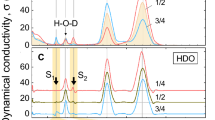Abstract
Mössbauer spectroscopy is highly sensitive to changes in the electric field gradient and electronic density around atomic nuclei, but cannot be used to study the electronic species of compounds in solutions because the necessary recoilless γ-ray resonance absorption has so far only been achieved in solids. We recently suggested1 the use of a Corning Vycor porous (‘thirsty’) glass2,3 carrier for the Mössbauer study of liquids. Here we show that the Mössbauer effect can be achieved in liquid samples trapped in the pores of this glass carrier, providing a new technique which may be a useful tool in solution chemistry.
This is a preview of subscription content, access via your institution
Access options
Subscribe to this journal
Receive 51 print issues and online access
$199.00 per year
only $3.90 per issue
Buy this article
- Purchase on Springer Link
- Instant access to full article PDF
Prices may be subject to local taxes which are calculated during checkout
Similar content being viewed by others
References
Burger, K. & Vértes, A. XXII int. Conf. on Coordination Chemistry, Budapest Vol. 1, 77 (1982).
Elmer, T. H., Nordberg, M. E., Carrier, G. B. & Korda, E. J. J. Am. Ceramic. Soc. 53, 171–175 (1970).
Espe, W. Materials of High Vacuum Technology, 414–416 (Pergamon, Oxford, 1968).
Burger, K., Vértes, A. & Zay, I. Inorg. chim. Acta 76, L247–250 (1983).
Author information
Authors and Affiliations
Rights and permissions
About this article
Cite this article
Burger, K., Vértes, A. Capillary Mössbauer spectroscopy for solution chemistry. Nature 306, 353–354 (1983). https://doi.org/10.1038/306353a0
Received:
Accepted:
Issue Date:
DOI: https://doi.org/10.1038/306353a0
This article is cited by
-
On the lack of capillary Mössbauer spectroscopic effect for SnII-containing aqueous solutions trapped in corning Vycor ‘thirsty’ glass
Journal of Radioanalytical and Nuclear Chemistry (2014)
-
Effect of hydration on the dynamics of polymeric cation exchangers and polymeric sorbent inferred from the Rayleigh scattering of Mössbauer radiation
Russian Chemical Bulletin (1998)
-
Mössbauer study of the structure of liquid nanophases trapped in porous silicate and solid microemulsion matrix
Colloid & Polymer Science (1997)
-
M�ssbauer spectroscopy of liquid SnCl4 solutions trapped in a rigid microemulsion
Structural Chemistry (1991)
-
On the enhancement of the recoilless fraction in restricted geometries
Hyperfine Interactions (1990)
Comments
By submitting a comment you agree to abide by our Terms and Community Guidelines. If you find something abusive or that does not comply with our terms or guidelines please flag it as inappropriate.



